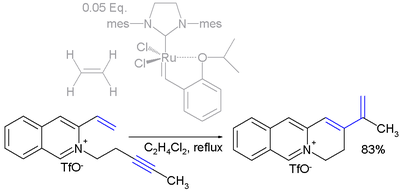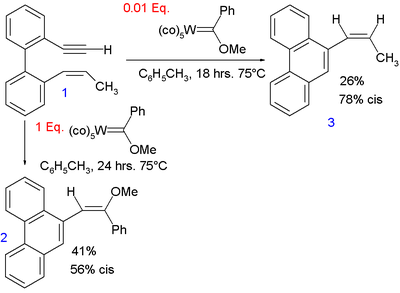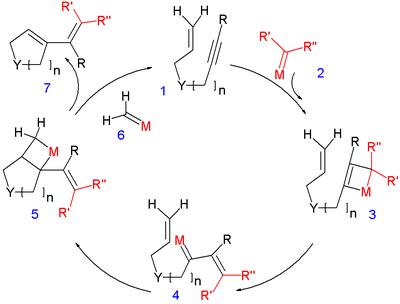
Enyne metathesis
Encyclopedia
An Enyne metathesis is an organic reaction
taking place between an alkyne
and an alkene
with a metal carbene catalyst forming a butadiene. This reaction is a variation of olefin metathesis
.
The general scheme is given by scheme 1:
When the reaction is intramolecular
(in an enyne
) it is called ring-closing enyne metathesis or RCEYM (scheme 2):
with Y representing oxygen
or nitrogen
and n an integer.
The reaction was first described in 1985 with the conversion of biphenyl
3.1 to a phenanthrene
in scheme 3:
The carbene is a tungsten
carbonyl
when used in stoichoimetric amounts (1 equivalent) yields 41% of the phenanthrene 3.2 and when used in catalytic amounts phenanthrene 3.3. The stereoselectivity
of this reaction is large with the metal atom exclusively adding to one of the alkyne carbon atoms in the initial reaction step.
for this reaction is outlined in scheme 4:
In the first catalytic cycle
the alkyne
group of enyne 4.1 forms a metallacyclobutene intermediate 4.3 with carbene 4.2 with R' and R' ' any organic group required to stabilized it. In the next step the metathesis step is reversed with formation of a new double bond and a new carbenic center in 4.4. The ring-closing step takes place when this center reacts with the alkene group to a metallacyclobutane 4.5 as in a regular olefin metathesis
reaction. The butadiene group forms in the last step with expulsion of a new methylene carbene, initiating the next cycle but now with R' = H and R' ' = H.
This is the proposed "yne-then-ene" mechanism. Evidence for an "ene-then-yne" pathway is beginning to emerge, especially for ruthenium based catalytic systems.
The driving force for this conversion is the formation of a thermodynamically stable conjugated
butadiene.
as is demonstrated in the reaction displayed in scheme 5:
Organic reaction
Organic reactions are chemical reactions involving organic compounds. The basic organic chemistry reaction types are addition reactions, elimination reactions, substitution reactions, pericyclic reactions, rearrangement reactions, photochemical reactions and redox reactions. In organic synthesis,...
taking place between an alkyne
Alkyne
Alkynes are hydrocarbons that have a triple bond between two carbon atoms, with the formula CnH2n-2. Alkynes are traditionally known as acetylenes, although the name acetylene also refers specifically to C2H2, known formally as ethyne using IUPAC nomenclature...
and an alkene
Alkene
In organic chemistry, an alkene, olefin, or olefine is an unsaturated chemical compound containing at least one carbon-to-carbon double bond...
with a metal carbene catalyst forming a butadiene. This reaction is a variation of olefin metathesis
Olefin metathesis
Olefin metathesis or transalkylidenation is an organic reaction that entails redistribution of alkylene fragments by the scission of carbon - carbon double bonds in olefins . Its advantages include the creation of fewer sideproducts and hazardous wastes. Yves Chauvin, Robert H. Grubbs, and Richard R...
.
The general scheme is given by scheme 1:
When the reaction is intramolecular
Intramolecular
Intramolecular in chemistry describes a process or characteristic limited within the structure of a single molecule, a property or phenomenon limited to the extent of a single molecule.- Examples :...
(in an enyne
Enyne
An enyne is a functional group in organic chemistry consisting of a conjugated alkyne and alkene group....
) it is called ring-closing enyne metathesis or RCEYM (scheme 2):
with Y representing oxygen
Oxygen
Oxygen is the element with atomic number 8 and represented by the symbol O. Its name derives from the Greek roots ὀξύς and -γενής , because at the time of naming, it was mistakenly thought that all acids required oxygen in their composition...
or nitrogen
Nitrogen
Nitrogen is a chemical element that has the symbol N, atomic number of 7 and atomic mass 14.00674 u. Elemental nitrogen is a colorless, odorless, tasteless, and mostly inert diatomic gas at standard conditions, constituting 78.08% by volume of Earth's atmosphere...
and n an integer.
The reaction was first described in 1985 with the conversion of biphenyl
Biphenyl
Biphenyl is an organic compound that forms colorless crystals. It has a distinctively pleasant smell. Biphenyl is an aromatic hydrocarbon with a molecular formula 2...
3.1 to a phenanthrene
Phenanthrene
Phenanthrene is a polycyclic aromatic hydrocarbon composed of three fused benzene rings. The name phenanthrene is a composite of phenyl and anthracene. In its pure form, it is found in cigarette smoke and is a known irritant, photosensitizing skin to light...
in scheme 3:
The carbene is a tungsten
Tungsten
Tungsten , also known as wolfram , is a chemical element with the chemical symbol W and atomic number 74.A hard, rare metal under standard conditions when uncombined, tungsten is found naturally on Earth only in chemical compounds. It was identified as a new element in 1781, and first isolated as...
carbonyl
Metal carbonyl
Metal carbonyls are coordination complexes of transition metals with carbon monoxide ligands. These complexes may be homoleptic, that is containing only CO ligands, such as nickel carbonyl , but more commonly metal carbonyls contain a mix of ligands, such as Re3Cl...
when used in stoichoimetric amounts (1 equivalent) yields 41% of the phenanthrene 3.2 and when used in catalytic amounts phenanthrene 3.3. The stereoselectivity
Stereoselectivity
In chemistry, stereoselectivity is the property of a chemical reaction in which a single reactant forms an unequal mixture of stereoisomers during the non-stereospecific creation of a new stereocenter or during the non-stereospecific transformation of a pre-existing one...
of this reaction is large with the metal atom exclusively adding to one of the alkyne carbon atoms in the initial reaction step.
Reaction mechanism
The reaction mechanismReaction mechanism
In chemistry, a reaction mechanism is the step by step sequence of elementary reactions by which overall chemical change occurs.Although only the net chemical change is directly observable for most chemical reactions, experiments can often be designed that suggest the possible sequence of steps in...
for this reaction is outlined in scheme 4:
In the first catalytic cycle
Catalytic cycle
A catalytic cycle in chemistry is a term for a multistep reaction mechanism that involves a catalyst . The catalytic cycle is the main method for describing the role of catalysts in biochemistry, organometallic chemistry, materials science, etc. Often such cycles show the conversion of a...
the alkyne
Alkyne
Alkynes are hydrocarbons that have a triple bond between two carbon atoms, with the formula CnH2n-2. Alkynes are traditionally known as acetylenes, although the name acetylene also refers specifically to C2H2, known formally as ethyne using IUPAC nomenclature...
group of enyne 4.1 forms a metallacyclobutene intermediate 4.3 with carbene 4.2 with R' and R' ' any organic group required to stabilized it. In the next step the metathesis step is reversed with formation of a new double bond and a new carbenic center in 4.4. The ring-closing step takes place when this center reacts with the alkene group to a metallacyclobutane 4.5 as in a regular olefin metathesis
Olefin metathesis
Olefin metathesis or transalkylidenation is an organic reaction that entails redistribution of alkylene fragments by the scission of carbon - carbon double bonds in olefins . Its advantages include the creation of fewer sideproducts and hazardous wastes. Yves Chauvin, Robert H. Grubbs, and Richard R...
reaction. The butadiene group forms in the last step with expulsion of a new methylene carbene, initiating the next cycle but now with R' = H and R' ' = H.
This is the proposed "yne-then-ene" mechanism. Evidence for an "ene-then-yne" pathway is beginning to emerge, especially for ruthenium based catalytic systems.
The driving force for this conversion is the formation of a thermodynamically stable conjugated
Conjugated system
In chemistry, a conjugated system is a system of connected p-orbitals with delocalized electrons in compounds with alternating single and multiple bonds, which in general may lower the overall energy of the molecule and increase stability. Lone pairs, radicals or carbenium ions may be part of the...
butadiene.
Scope
Enyne metathesis reactions are accelerated by ethyleneEthylene
Ethylene is a gaseous organic compound with the formula . It is the simplest alkene . Because it contains a carbon-carbon double bond, ethylene is classified as an unsaturated hydrocarbon. Ethylene is widely used in industry and is also a plant hormone...
as is demonstrated in the reaction displayed in scheme 5:
- In this reaction with the Hoveyda-Grubbs Catalyst, ethylene converts the alkyne group to the corresponding diene
 DieneIn organic chemistry a diene or diolefin is a hydrocarbon that contains two carbon double bonds.Conjugated dienes are functional groups, with a general formula of CnH2n-2. Dienes and alkynes are functional isomers...
DieneIn organic chemistry a diene or diolefin is a hydrocarbon that contains two carbon double bonds.Conjugated dienes are functional groups, with a general formula of CnH2n-2. Dienes and alkynes are functional isomers...
group prior to the reaction with the alkene group.





